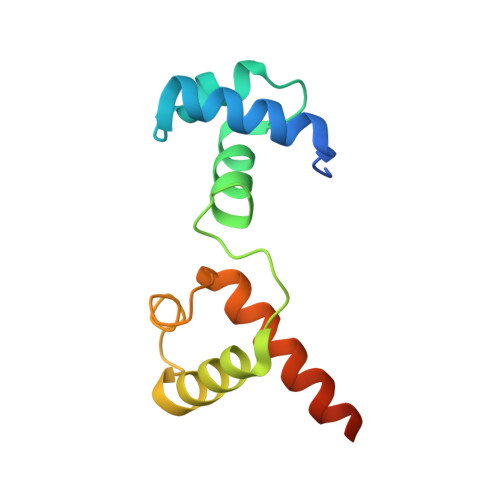Two distinct nucleic acid binding surfaces of Cdc5 regulate development.
Wang, C., Li, M., Li, G., Liu, X., Zhao, W., Yu, B., Liu, J., Yang, J., Peng, Y.L.(2019) Biochem J 476: 3355-3368
- PubMed: 31652438
- DOI: https://doi.org/10.1042/BCJ20190502
- Primary Citation of Related Structures:
6JUI - PubMed Abstract:
Cell division cycle 5 (Cdc5) is a highly conserved nucleic acid binding protein among eukaryotes and plays critical roles in development. Cdc5 can simultaneously bind to DNA and RNA by its N-terminal DNA-binding domain (DBD), but molecular mechanisms describing its nucleic acid recognition and the regulation of development through its nucleic acid binding remain unclear. Herein, we present a crystal structure of the N-terminal DBD of MoCdc5 (MoCdc5-DBD) from the rice blast fungus Magnaporthe oryzae. Residue K100 of MoCdc5 is on the periphery of a positively charged groove that is formed by K42, K45, R47, and N92 and is evolutionally conserved. Mutation of K100 significantly reduces the affinity of MoCdc5-DBD to a Cdc5-binding element but not to a conventional myeloblastosis (Myb) domain-binding element, suggesting that K100 is a key residue of the high binding affinity to Cdc5-binding element. Another conserved residue (R31) is located close to the U6 RNA in the structure of the spliceosome, and its mutation dramatically reduces the binding capacity of MoCdc5-DBD for U6 RNA. Importantly, mutations in these key residues, including R31, K42, and K100 in AtCDC5, an Arabidopsis thaliana ortholog of MoCdc5, greatly impair the functions of AtCDC5, resulting in pleiotropic development defects and reduced levels of primary microRNA transcripts. Taken together, our findings suggest that Cdc5-DBD binds nucleic acids with two distinct binding surfaces, one for DNA and another for RNA, which together contribute to establishing the regulation mechanism of Cdc5 on development through nucleic acid binding.
Organizational Affiliation:
Key Laboratory of Pest Monitoring and Green Management, Ministry of Agriculture and Rural Affairs, Joint Laboratory for International Cooperationin Crop Molecular Breeding, Ministry of Education, and Department of Plant Pathology, College of Plant Protection, China Agricultural University, Beijing 100193, China.














